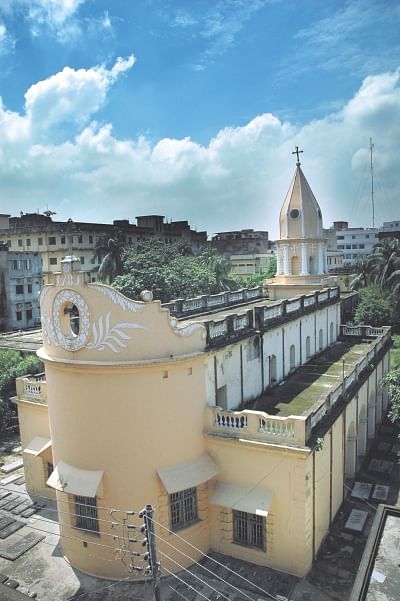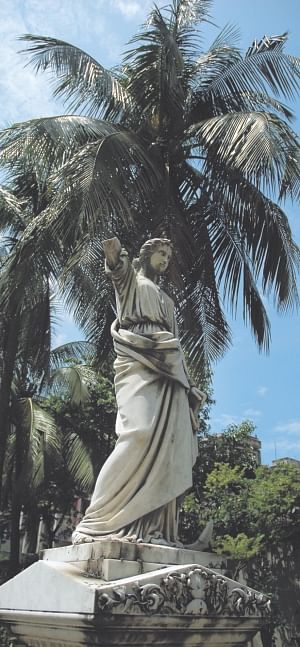| Home - Back Issues - The Team - Contact Us |
 |
| Volume 11 |Issue 13| March 30, 2012 | |
|
|
Heritage The Armenian Community in Dhaka A Living Relic Sharmin Ahmed Old Dhaka makes one think of delicious traditional food and beautiful archaeological landmarks that reflect much on the past of Bengal. It houses some of the oldest heritage sites of the country; one such site is the popularly known Armani Church, which is situated in the neighbourhood of Armanitola and named after the Armenian community that once thrived there. Approaching the entrance of the Armenian Apostolic Church of Holy Resurrection of Dhaka established in 1781, one cannot help but notice the unique and elaborate designs adorning it. Once through the rusty green collapsible gates, one is let into a yard of concrete graves -- some with cross tomb-stones and others engraved with intricate patterns and messages written in both English and Armenian. A delicately carved statue of a woman, as if overlooking the other graves, immediately catches the eye. It's the tombstone of Avetick Thomas, who died in 1877. One of the hands of the beautiful statue has been broken off at the elbow, or "perhaps stolen, by local trespassers and hooligans," as Shankar, the lone assistant to the only caretaker of the church suggests.
The interior of the church, where the masses are conducted, is a masterpiece itself with the portraits of the Crucifixion and The Last Supper painted on the dome-like alter. A beautiful icon of Jesus Christ by an Anglo-Indian painter Charles Paut, a teacher of Pogoes School in Dhaka, stands proudly right next to the paintings. However, it is distressing that the church is the only known trace of the existence of Armenians. Michael Joseph Martin, who serves as the only caretaker of the church and whose Armenian name is Mikel Housep Martirossian, says, "There are no Armenians in Armanitola now." He explains that the few families that live in the country are scattered in and around Dhaka; the rest are either expatriates or have married into Bengali families. Charmaine Jacqueline Mendes, who comes from the Manook (Manuk) family which has been in the sub-continent since 1947, says, "The number of Armenians in Dhaka has fallen rapidly and progressively. Almost all have migrated. Today, other than the Martin's, the only person I know of Armenian descent in Bangladesh is myself, and my two daughters. The total Armenians in Bangladesh presently do not exceed six in number." The existence of Armenians in this part of the continent can be traced back to the twelfth century, when they were lured by trade prospects on the banks of the Buriganga river, which was once a trading hub. "They came for the silk, muslin, precious stones and spices, and started the jute, indigo, salt and leather businesses," says Martin. These Armenians were highly educated, and had a strong hold of trade in Bangladesh for almost 2000 years. "The Armenians were illustrious in setting up colonies of trade and religion" says Martin. This is evident, he explains, when examining their role in trade at the time of the British East India Company, and even during the time of Akbar. The wealthy Armenian merchants were not only apt in the British acquisition and control of trade in the 18th Century. But from the earliest days of European trade with the area, the Armenian merchants acted as middle men and suppliers to the European nations. This was a major source of their immense wealth.
Even after the British took control of their own trade, the Armenian merchants transformed from acting as middle men, to buying the Zaminder (landlords) rights to land, financial administration and tax gathering, led by affluent families like the Pogoes, Agacy, Michael, Stephen, Joakim, Sarkies, Arathon (Aratun), Coja (Khojah) and Manook (Manuk). Khwaja Hafizullah, a merchant prince, laid the foundations for the Dhaka Nawab Family by accumulating wealth and doing business with Greek and Armenian merchants. This trend was followed by his nephew and the first Nawab of the family, Khwaja Alimullah. Parts of the gardens of Shahbag, Ruplal House (a major landmark in old Dhaka) and the land where Bangabhaban stands belonged to Armenian Zamindars. There is still a Manook House inside Bangabhaban, bearing the name of the original owner's family. The early Armenian settlers were dedicated to their unique strand of Christian faith that dates back to the earliest days of Christianity, even before the spread of the Eastern-Orthodox religion. They built a small chapel in the midst of their community graveyard. By the end of the 18th century, the Armenian colony in Dhaka had grown significantly and the chapel was found inadequate for the needs of the community. Major donations were made by Michael Sarkies, Astwasatoor Gavork, Margar Pogose and Khojah Petrus. And they finally replaced the chapel with the Holy Resurrection Church which was completed in 1781. The church may be rooted in history, but it is located in one of the busiest part of the city. The roads nearby are so crowded that services cannot be held during the working week as the multi-denominational expatriate congregation would never get there on time. Thus, masses are held only on special occasions like Christmas and Easter, but instead of Sundays, they are held on Fridays. But Mendes also adds that, "For many years, the international Armenian diaspora community, who have been aware of our presence in Bangladesh, have been in contact and provided and offered help in preserving and keeping alive our traditions in Bangladesh. The international community residing in Dhaka has also popularised us through their visits to our church and services. Jointly, we can work on bringing back the glories of the original Armanitola.” Martin states, "Most Armenians have left Bangladesh, so it is up to me and my family to make sure this relic from a long-gone era is preserved. We are a self funded community, and we do not need funding or any other support for maintenance.” However, Martin is disappointed that greedy, influential, occupiers are trying to take over the little property left to the dwindling Armani community in Dhaka. "Corruption and lack of proper system is the main reason why this community is diminishing in Dhaka; even before 1971, the cancellation of trading licence to various big companies resulted in them leaving the country". He also adds that the embassies are not well maintained and are inefficient, which is why traders find it difficult to come here. Traces of this community still exist in Dhaka, beyond the Church, in the form of the Pogose School in Dhaka, established in 1848, as the first private school of the country by JG Nicholas Pogose. According to historian Muntasir Mamun, in "Dhaka: Smriti Bismritir Nagari" (Dhaka: The City of Memoirs and Forgetfulness), the school was named Pogoes Anglo Vernacular School at Dhaka, was taken over by Mohinimohon Das in 1878, after Pogose himself left Dhaka for London. After the death of Mohinimohon Das in 1896 the school was looked after by the trustee board of the Zamindari Estate and moved it to Chittaranjan Avenue. Mendes says, "The government has a lead role for the preservation of its societies and peoples; the civil society and the media has been robustly keeping our presence alive through oral traditions, through their public and private remembrances and discussions of our institutions like Pogose School.” The Armenian Church, maintained lovingly by Martin and Shankar, is an enduring symbol of a prolonged and intriguing connection between the somewhat elusive Armenian people and Bengal. It should be ensured that this bond of centuries be preserved and cherished. Copyright
(R) thedailystar.net 2012 |

